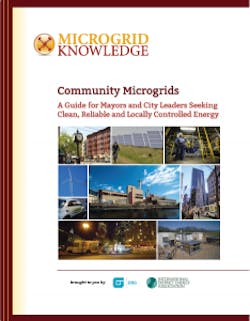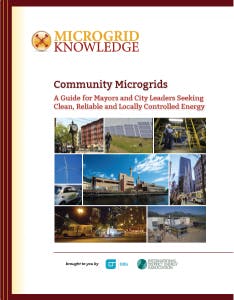Community Microgrids: Central Pillar of the Local Energy Revolution
Community microgrids are popping up in cities and towns all over the U.S. as the local energy revolution takes hold. Recent storms and power outages are helping drive this trend, as well.
Download the Microgrid Knowledge Community Microgrid Guide.
A guide from Microgrid Knowledge, explores the role of the community microgrid and its growing popularity as many city leaders look for more clean, reliable and locally controlled energy. But how do these leaders get started?
The guide, the third in Microgrid Knowledge’s Think Microgrid series, provides a step-by-step primer on first explorations into community microgrids. The truth is, information about clean and local energy might be in high demand, but there isn’t much literature and guidance available for municipal leaders who are exploring the concept.
First, the guide explores some of the most important definitions associated with community microgrids. Think the U.S. electric grid, for example. According to the report, the U.S. electric grid delivers power to more than 140 million customers by way of more than 3,000 electric utilities. Or how about community microgrids themselves? A community microgrid has lots of benefits, but above all, it is focused on ensuring that the citizenry receives critical services during a grid outage.
[clickToTweet tweet=”A community microgrid is focused on ensuring that the citizenry receives critical services during a grid outage.” quote=”A community microgrid is focused on ensuring that the citizenry receives critical services during a grid outage.”]
The guide also covers the evolution of community microgrids. Believe it or not, this is not new technology. In fact, many colleges and universities have been using microgrids for decades (not to mention they’ve been around since the time of Thomas Edison). The Princeton University microgrid, in particular, was lauded for its continuous operation during SuperStorm Sandy, as cities up and down the northeast coast were without power.
So, what are these microgrids? The hard part is, it’s not a one-size-fits-all game. But ultimately, they are described as “mini versions of the larger electric grid” because they mimic the grid on a much smaller scale.
Microgrid Knowledge also defines four reasons for community microgrids that will resonate with a variety of different municipalities. These include how microgrids can strengthen the central grid, as well as keep lights on in a crisis. They also can enhance community economics and improve the environment.
There are also a variety of incentives and different types of financing for cities to explore when looking into a community microgrid. These range from government funding to private financing. The guide explores some of these avenues in detail.
Ready to get started? The report will share how to compensate microgrids fairly and how t0 manage the utility relationship. Lastly, Microgrid Knowledge explores a variety of successful community microgrids across the country, from Jamestown, N.Y., on the east coast, all the way to California’s Blue Lake Rancheria, a tribal community in Humboldt County.
The full community microgrid guide from Microgrid Knowledge explores the following topics:
- Introduction to Community Microgrids
- Key Definitions
- Evolution of the Microgrid
- Four Good Reasons for Community
- Incentives and Financing for Community Microgrids
- First Steps and Future Promise
- Community Microgrids in U.S. Cities and Towns
Download the full report, “Community Microgrids: A Guide for Mayors and City Leaders Seeking Clean, Reliable, and Locally Controlled Energy,” free of charge and courtesy of Veolia, to read more on how community microgrids are at the forefront of the local energy revolution.

